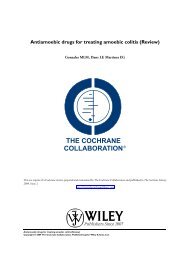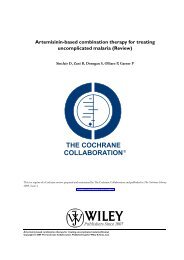Interventions for treating proximal humeral fractures in adults (Review)
Interventions for treating proximal humeral fractures in adults (Review)
Interventions for treating proximal humeral fractures in adults (Review)
Create successful ePaper yourself
Turn your PDF publications into a flip-book with our unique Google optimized e-Paper software.
0.06 to 0.97). However, Rommens 1993 reported that they had<br />
found no differences <strong>in</strong> the end result, either <strong>in</strong> terms of fracture<br />
heal<strong>in</strong>g or functional outcome.<br />
(b) Cont<strong>in</strong>u<strong>in</strong>g management (rehabilitation) after <strong>in</strong>itial conservative<br />
treatment <strong>in</strong>volv<strong>in</strong>g sl<strong>in</strong>g immobilisation<br />
Two trials compared conventional physiotherapy dur<strong>in</strong>g the 12<br />
weeks follow<strong>in</strong>g trauma with self-treatment follow<strong>in</strong>g a course of<br />
<strong>in</strong>struction (Bertoft 1984; Lundberg 1979). Un<strong>for</strong>tunately, data<br />
from these two small trials could not be pooled because of <strong>in</strong>compatible<br />
outcome measures. In both trials there were no statistically<br />
significant differences between those receiv<strong>in</strong>g <strong>in</strong>struction <strong>for</strong> exercises<br />
at home and those undergo<strong>in</strong>g supervised physiotherapy <strong>in</strong><br />
any of the outcomes recorded (see Analyses 04.01 to 04.06).<br />
Revay 1992 reported that the addition of supervised exercises <strong>in</strong><br />
a swimm<strong>in</strong>g pool to self-treatment did not enhance long term<br />
outcome. Participants of the control group (self-treatment only)<br />
were reported as hav<strong>in</strong>g significantly better functional movements,<br />
jo<strong>in</strong>t mobility and activities of daily liv<strong>in</strong>g at two and three month<br />
follow up. However, there were no significant differences at one<br />
year. Revay 1992 suggested that those us<strong>in</strong>g the pool may have<br />
neglected their home exercises, but the authors did not evaluate<br />
compliance.<br />
Livesley 1992 reported that there was no difference <strong>in</strong> outcome<br />
between the two groups (receiv<strong>in</strong>g pulsed electromagnetic high<br />
frequency energy (PHFE) versus placebo) at any stage of the trial,<br />
but provided no quantitative data. All trial participants were reported<br />
as achiev<strong>in</strong>g a “good” result as converse to a “poor” one.<br />
(2) Surgical treatment versus conservative treatment<br />
Three trials evaluated surgical <strong>in</strong>terventions <strong>for</strong> displaced or highgrade<br />
fracture configurations, or both.<br />
Kristiansen 1988 studied 30 people with 31 displaced two, three<br />
or four-part <strong>fractures</strong>, and assessed the quality of fracture reduction,<br />
heal<strong>in</strong>g and function. Fractures were reduced under general<br />
anaesthetic either by attempt<strong>in</strong>g to skewer the fracture fragments<br />
us<strong>in</strong>g a Ste<strong>in</strong>mann p<strong>in</strong> <strong>in</strong>serted transcutaneously, or by simple<br />
closed manipulation alone. Treatment failure, def<strong>in</strong>ed as a change<br />
of method result<strong>in</strong>g from a poor <strong>in</strong>itial fracture reduction or removal<br />
of p<strong>in</strong>s due to <strong>in</strong>fection, occurred <strong>in</strong> three cases (see Analysis<br />
05.01). Overall, the quality of fracture reduction was probably better<br />
<strong>in</strong> the surgical group. However, s<strong>in</strong>ce the reduction was held <strong>in</strong><br />
these patients by application of an external fixator (the Ste<strong>in</strong>mann<br />
p<strong>in</strong> was removed) and <strong>in</strong> the other group by use of a simple sl<strong>in</strong>g,<br />
the long-term results reflect the overall effect of <strong>in</strong>itial treatment<br />
and method of immobilisation. Of those followed up to one year,<br />
fewer participants of the surgical group had a poor or unsatisfactory<br />
rat<strong>in</strong>g of function (see Analysis 05.02: 3/11 versus 6/10; RR<br />
0.45, 95% CI 0.15 to 1.35). Data provided <strong>for</strong> the complications<br />
of avascular necrosis, non-union and refracture are presented <strong>in</strong><br />
Analysis 05.03. None of the differences between the two groups<br />
<strong>for</strong> the outcomes shown <strong>in</strong> the analyses were statistically significant.<br />
<strong>Interventions</strong> <strong>for</strong> <strong>treat<strong>in</strong>g</strong> <strong>proximal</strong> <strong>humeral</strong> <strong>fractures</strong> <strong>in</strong> <strong>adults</strong> (<strong>Review</strong>)<br />
Copyright © 2008 The Cochrane Collaboration. Published by John Wiley & Sons, Ltd.<br />
Zyto 1997 <strong>in</strong>cluded only people with displaced three and fourpart<br />
<strong>fractures</strong> <strong>in</strong> their analyses. Forty patients were allocated either<br />
to surgical treatment with cerclage wir<strong>in</strong>g of the displaced<br />
fragments, which <strong>in</strong> some cases was placed around longitud<strong>in</strong>al<br />
wires <strong>in</strong> tension band fashion, or conservative treatment where<br />
the <strong>in</strong>jured arm was supported <strong>in</strong> a sl<strong>in</strong>g. No manipulation of<br />
the fracture was attempted <strong>in</strong> the conservative group. One year<br />
later, there were major complications only <strong>in</strong> the surgical group<br />
(see Analysis 06.01). At 50 months, only 29 participants were reviewed.<br />
Displacement of the greater tuberosity was found <strong>in</strong> three<br />
people treated conservatively and osteoarthritis <strong>in</strong> two people <strong>in</strong><br />
each group (see Analysis 06.01). Similarly, there were no statistically<br />
significant differences between the two groups at either one<br />
or three years <strong>in</strong> subjective assessment of function (see Analyses<br />
06.02). Similarly, there was no difference at three years <strong>in</strong> the Constant<br />
score (Constant 1987) <strong>in</strong> terms of the overall functional score<br />
(see Analysis 06.03: MD -5.00, 95% CI -17.52 to 7.52). Though<br />
statistically significant, the cl<strong>in</strong>ical relevance of the three po<strong>in</strong>t difference<br />
<strong>in</strong> the range of motion component of the Constant score<br />
is questionable (see Analyses 06.03 <strong>for</strong> the ma<strong>in</strong> components of<br />
the Constant score: pa<strong>in</strong>, range of motion, power and activities of<br />
daily liv<strong>in</strong>g).<br />
Stable<strong>for</strong>th 1984 <strong>in</strong>cluded 32 people with displaced four-part <strong>fractures</strong><br />
<strong>in</strong> their comparison of an uncemented Neer prosthesis versus<br />
closed manipulation. The <strong>for</strong>earm and elbow were supported<br />
<strong>in</strong> a sl<strong>in</strong>g <strong>in</strong> both groups, and supervised physiotherapy was provided<br />
to all participants between three and six months. Two surgical<br />
group participants developed haematomas; one resolved but<br />
the other became <strong>in</strong>fected and the prothesis was subsequently removed.<br />
One person <strong>in</strong> each group died be<strong>for</strong>e six months from<br />
“causes unrelated” to their fracture. By six months, significantly<br />
fewer participants of the prosthesis group needed some help with<br />
activities of daily liv<strong>in</strong>g or had died (see Analysis 07.03: 2/16 versus<br />
9/16; RR 0.22, 95% CI 0.06 to 0.87). Nearly all trial participants<br />
had shoulder pa<strong>in</strong> but significantly fewer <strong>in</strong> the prosthesis group<br />
reported pa<strong>in</strong> that impaired sleep or function (see Analysis 07.04:<br />
2/13 versus 9/12; RR 0.21, 95%CI 0.06 to 0.76). This result is<br />
no longer statistically significant <strong>in</strong> a worst case analysis where<br />
the miss<strong>in</strong>g participants of the prosthesis group are assumed to<br />
be <strong>in</strong> constant pa<strong>in</strong>, whereas those miss<strong>in</strong>g from the conservative<br />
group are not (4/15 versus 9/15; RR 0.44, 95% CI 0.17 to 1.13;<br />
NS). Reduced muscle strength and restricted mobility were less<br />
frequent <strong>in</strong> the prosthesis group survivors (see Analyses 07.05 and<br />
07.06).<br />
(3) Different methods of surgical management<br />
The one trial <strong>in</strong> this category (Hoellen 1997) compared <strong>humeral</strong><br />
head replacement with an endoprosthesis (<strong>in</strong>ternally placed implant)<br />
aga<strong>in</strong>st reduction and stabilisation of the fracture us<strong>in</strong>g tension<br />
band wir<strong>in</strong>g. All 30 patients reported <strong>in</strong> Hoellen 1997 had<br />
four-part <strong>fractures</strong>, as per the reported study <strong>in</strong>clusion criteria.<br />
Patients with three-part <strong>fractures</strong> were also eligible accord<strong>in</strong>g to<br />
11








